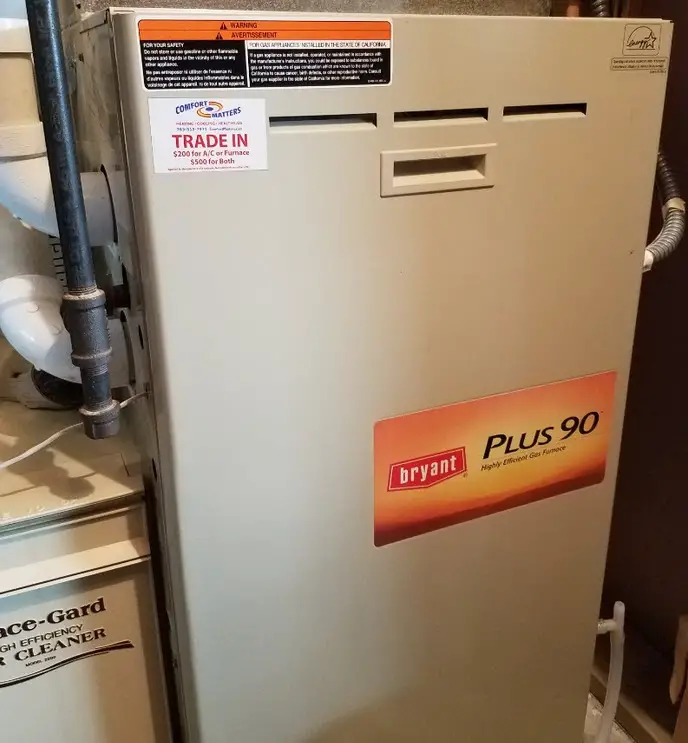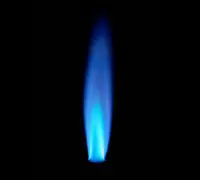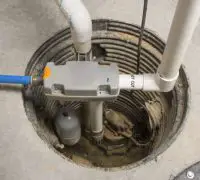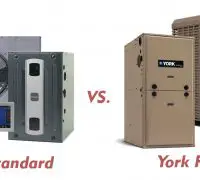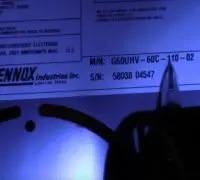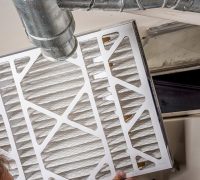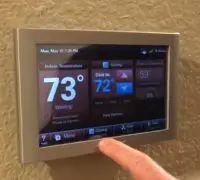The Bryant Legacy Plus 90 is a single-stage gas rated furnace with an AFUE rating of 95.5%. The Plus 90 utilizes Bryant’s Fan On Plus technology to improve air circulation and fan monitoring. The furnace is made with a low-noise combustion system for silent operation and a high-efficiency air filter cabinet to enhance air quality. The furnace comes with pilot-free ignition, on-board diagnostics, and a digital thermostat for effortless use.
The Bryant Plus 90 comes with a condensation humidifier for collecting the moisture from the burned gasses inside the system. The humidifier will eliminate water through the home drainage system. You will be able to troubleshoot some of the most common issues with the 90, but you should call the professionals for the more difficult problems and repairs.
Bryant Plus 90 is provided with a 10-year limited parts warranty and a lifetime warranty for the heat exchanger. There’s also a warranty for the secondary heat exchanger; it’s a 20-year labor limited warranty for it. Should you register your furnace after 90 days, you get a 5-year warranty for the parts and a 20-years warranty for the heat exchanger. Should you want to add extended warranties, such as covering labor spending, you can do it.
Page Table of Contents
What should you do before asking for a “service call”?
When the furnace isn’t performing or running correctly, you shouldn’t hurry up and call the service. You may check several things before contacting the professionals.
No matter the issue developed by your furnace, it’s wise to record the LED status code before removing the blower access door. You should also register the LED status code before you turn the power off to the furnace. The status code is a two digit number with the first digit given by the number of yellows LED flashes, whereas the number of green LED flashes gives the second digit. The error codes give you an idea of what’s wrong with the furnace when it’s not correctly operating.
Here are the most common symptoms of Bryant 90 Plus and tips you may try for fixing:
Insufficient airflow
The filters could be dirty, so you should give them a look. Also, make sure that the supply-air grilles and the return-air grilles aren’t blocked; they may also affect the airflow. You have to ensure that they’re open and free. Should none of these steps fix the furnace, you should call for service.
The furnace fails to run.
You will have to follow the checklist step by step, moving to the next step only when the furnace doesn’t start.
Take a look at the thermostat.
Every component is essential for the Bryant 90 plus and modern furnaces, as they improve the accurate performance. Sometimes, a faulty thermostat can affect the furnace’s performance. Make sure that the thermostat has the desired temperature.
- Is the temperature set above room temperature?
- Did you set the thermostat to HEAT mode?
- Take a look at the fuses and circuit breakers too. Is the electrical power supply turned on?
When troubleshooting your furnace, you have to follow the checklist accordingly, as even a minor issue such as improper set temperature can cause a problem with the furnace. See if the manual shut-off valve in the gas supply pipe going to the furnace is open. Keep in mind to turn off the electrical supply before going any further with the checklist.
Is the control switch on the gas valve in an On position?
You will have to go on with the start-up steps if you need to reset switch to the On position. Take a look at the manual reset rollout switch placed on the burner box. Should the furnace go through the high-temperature condition, the controller will turn off the unit. You will have to push the button on the switch for resetting. If it trips again, you will need to turn off the furnace and call the technician.
Check the vent termination.
Any obstructions close to the vent termination may also affect the proper operation of the furnace. When the unit still doesn’t run, you should call the technician.
How should you troubleshoot the Bryant Plus 90?
When it comes to modern and high-efficiency gas furnaces such as Bryant 90, you need to be meticulous when addressing any issues. Here are the most common steps to take for identifying the cause of improper operation of your gas furnace.
Step 1
Begin with turning the thermostat to 5 degrees higher than the temperature inside your house. Your furnace should begin to operate.
Step 2
If the furnace doesn’t kick on, you need to go to the breaker box inside the box. If the breaker has tripped, you will need to turn the breaker to the “On” position.
Step 3
Identify the gas valve on the furnace’s back. You may now turn the gas valve to the “Off” position and wait for 5 minutes; smell the valve for gas afterward. When you sense any gas smell from the valve, you should call the gas company right away.
Step 4
Get a screwdriver and take the screws that hold the service door on the furnace out. It’s time to remove the furnace’s filter and see if there’s dirt or dust collected on it. If it’s filthy, you should replace the filter. Also, remove the filter if you notice breaks in the material.
Step 5
Scrutinize the bottom of the furnace. If you notice any debris or dust, you should clean the bottom of the furnace. Use a wet cloth for cleaning the vents and grills around the furnace so that the furnace operates correctly.
Step 6
Don’t forget to check the ventilation in your gas furnace. Please ensure that there are no obstructions or boxes that could block the ventilation to the furnace, affecting its performance.
Go over the checkup list for your furnace. It’s important!
The gas furnace isn’t something that you buy every day, so you should properly take care of it. Regular maintenance and annual checkup from a professional are some of the things you should do to help your furnace run properly. The next checklist is a guideline for proper servicing:
- Take a look at all flue gas passages, burners, coupling boxes, heat exchangers, and inducer assembly.
- Inspect the gas pipes that go to and inside the furnace; see that there are no leaks.
- Examine and clean the blower motor and wheel. Remember that you don’t need to lubricate the inducer and blower motors as they come pre-lubricated. They’re easy to recognize because they don’t have oil ports on every end of the engine.
- Observe and clean/change the air filters accordingly.
- Examine the supply and return-air ducts for air leaks, obstructions, and insulation. Should you identify any issues, don’t postpone fixing.
- Please look at the return-air duct connections at the furnace; they should be sealed to the furnace casing and present no cracks.
- Examine the connections, electrical wiring, and components to identify any loose connections.
- Make an operational check to see if the furnace runs correctly and if it needs adjustments or not.
- Inspect every condensate drain tube and condensate trap assembly; see that there are no leaks.
- Hire a qualified service agency for cleaning the condensate removal system once a year
- Take a look at the physical support of the furnace. See that there are no gaps, cracks, sagging around the base.
- Physically examine the furnace; any sign of deterioration should be investigated.
- Run seasonal inspections for the furnace to reduce the risk of improper operation.
